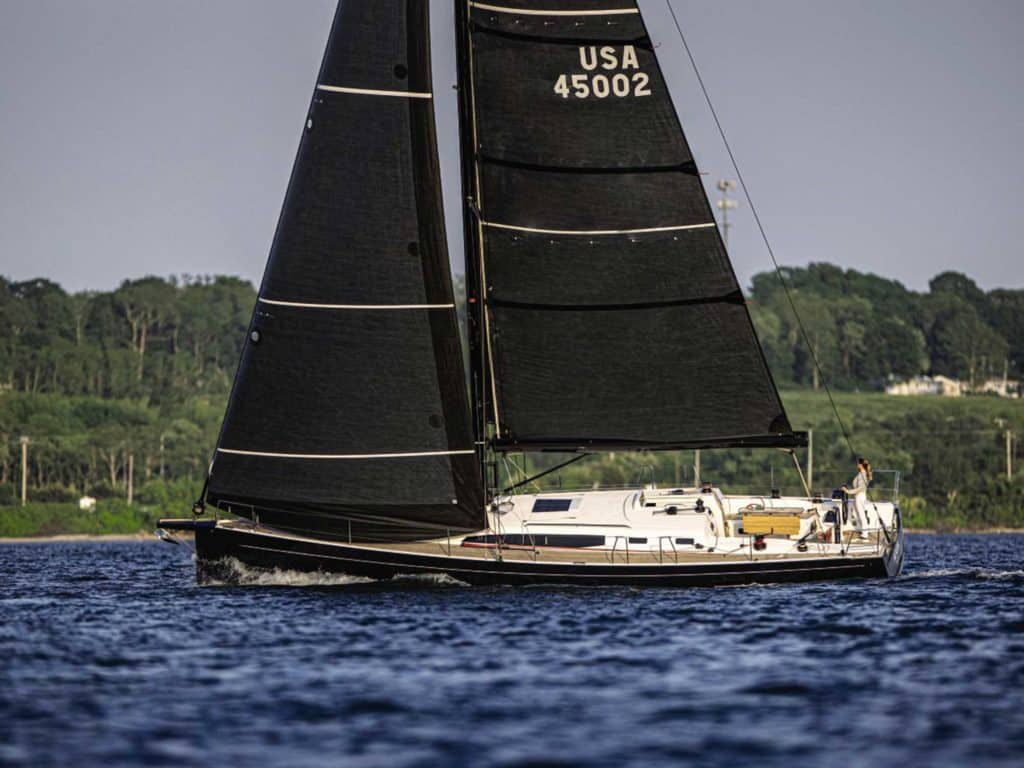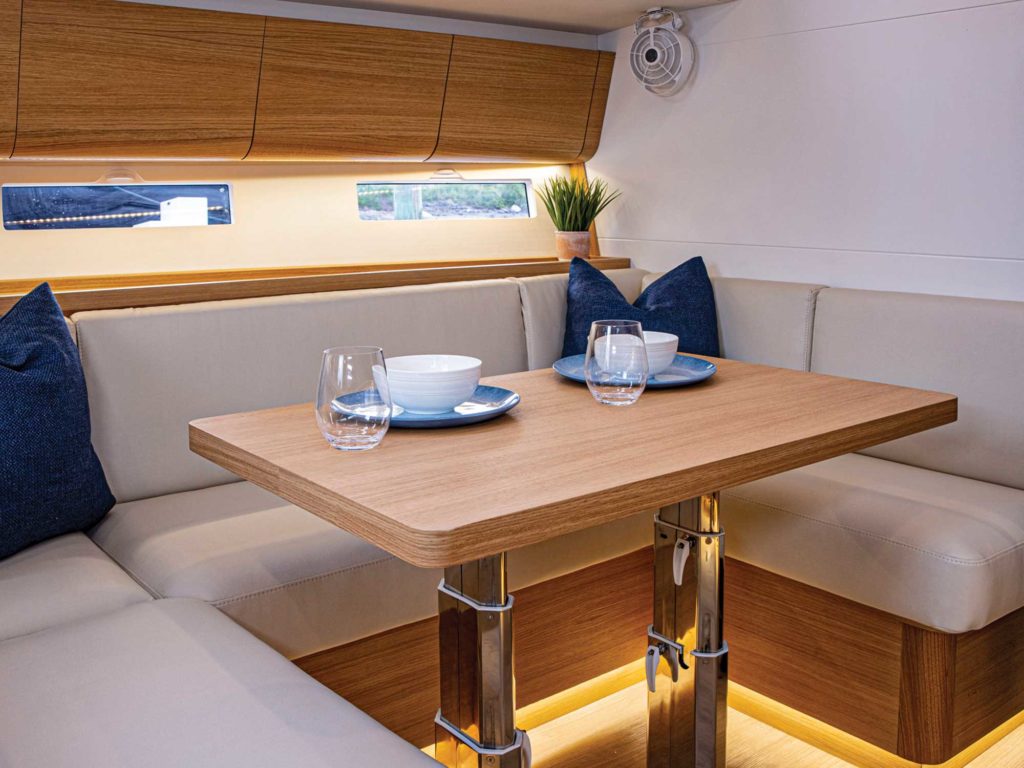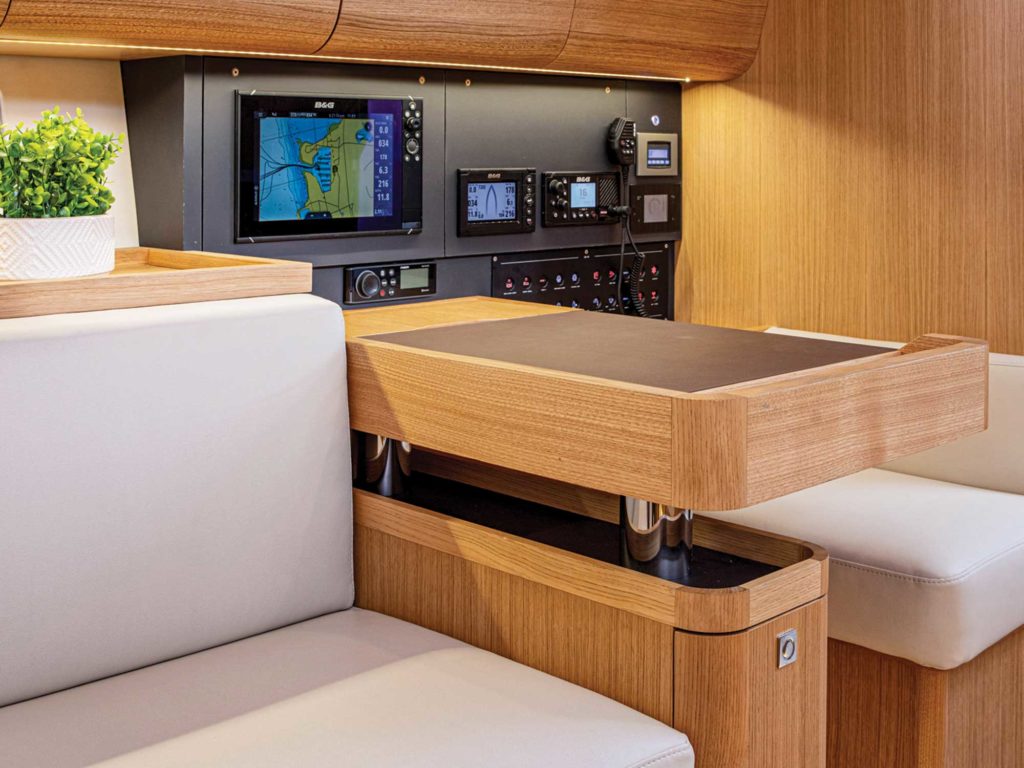
Sailing performance was definitely a factor for Erik Asgeirsson when he began his search for a new sailboat. Currently the fleet captain at the American Yacht Club in Rye, New York, he’s a racing sailor and has been part of a crew who campaigned his uncle’s J/35 around the buoys for many seasons. But after years of owning a Pearson 10M, and with four daughters between the ages of 8 and 14—not to mention a fondness for the rocky coast of Maine—he also wanted a family-friendly cruising boat, which will be shared with a co-owner and his family at the club.
By luck, Al Johnstone and the team at J/Boats had just such a dual-purpose vessel in mind when they sketched out their newest model, the J/45. They envisioned a performance-oriented, offshore-capable sailboat that would be equally at home both on the Newport Bermuda Race starting line and on an extended cruise to anywhere.
Having launched several smaller (and a few more racing-oriented) boats in the past decade, J/Boats president Jeff Johnstone saw the J/45 as an intentional return to bigger, multipurpose boats. Speaking just ahead of the start of this year’s Newport Bermuda Race, Johnstone noted that out of the nearly 200 boats entered, more than 50 were J/Boats.
But back to the new 45-footer. Asgeirsson and his partner went over the plans, liked what they saw, and ultimately took possession of Hull No. 2 this past spring at the J Composites yard in Les Sables-d’Olonne, France. (J Composites is the longtime builder of J/Boats in Europe and the co-developer of the J/45 and several other models.)
Asgeirsson was aboard Acadia for a 400-mile shakedown cruise to the United Kingdom, where the boat was loaded onto a ship and delivered to Narragansett Bay in early June.
To say he was satisfied with the boat would be an understatement. “It’s been a great project,” he told me when I arrived for a sea trial at Safe Harbor New England Boatworks in Portsmouth, Rhode Island.
On the dock, I found a lively scene as sailmakers and techs swarmed over the boat, tweaking this and adjusting that in preparation for Acadia’s impending delivery home to Rye.
With a dark-blue hull, slightly reversed bow, open transom, teak decks and white cabin top, Acadia makes a stunning first impression. I couldn’t help but pause to take in the carbon-fiber spar and in-boom roller furler, the no-nonsense nearly straight sheer of the deck, and the carbon-fiber bowsprit that sits atop a stainless-steel anchor roller. There was a lot there to please the eye.
Asgeirsson and his partner have added several options to the standard J/45 to enhance the dual-purpose nature of the boat, bringing the cost of Acadia to right around $950,000, delivered to the US. These include Harken Performa winches, one of which is electric to handle the main halyard (electric all around is also an option); a dual function hydraulic panel for the backstay and boom vang; a carbon Furler Boom from Denmark; a full quiver of top-of-the-line North Sails; and composite standing rigging from Future Fibres, another company under the North umbrella. Other add-ons include air conditioning, generator, teak in the cockpit and on the side decks (Flexiteek is standard), a suite of B&G electronics, a retractable bow thruster, and a removable inner forestay that adds numerous options when setting headsails.
On deck, I thought gear was well laid out. It’s easily accessible for a shorthanded skipper, but at the same time, there’s plenty of room in the cockpit, forward of the twin wheels and traveler, for friends and family to relax or for a racing crew to go to work. The side decks adjacent to the helms are at just the right height to provide the skipper with a comfortable place to sit and steer. Visibility forward is excellent. Underway, I liked the location of the drop-leaf cockpit table, which provides a rock-solid handhold when moving about, and the beveled footrest below it for bracing when heeled.
The mainsail is controlled by a double-ended German-style mainsheet, with tails reachable from either wheel. Primary winches are also nearby. Fairleads for the jib sheets are adjustable from the cockpit. A cruising sailor might set them and forget them; racers might tweak their location and further adjust sheeting angles using the friction-ring
inhaulers, also led back aft.
The J/45’s side decks are wide, with raised toe rails that should ensure good footing when things get wet and slippery. Forward, there’s a deep sail locker that also provides access to the chain locker in the forepeak, sealed off by a watertight door.

Stepping below, I found the cruising virtues of the J/45 to be immediately apparent. Rather than offering the bare-bones interior of a racing machine, J/Boats turned things over to French designer Isabelle Racoupeau, who has worked with a number of European luxury yachtbuilders.
Acadia’s interior trim and furniture are white oak (walnut is standard), set off with plain white panels and cushions. Furniture corners are rounded to prevent boat bites, and counters have proper fiddles so that things stay put. The look is simple but elegant.
The saloon has a dining table with U-shaped seating outboard to port and a settee opposite. The galley is just aft, to port, at the foot of the companionway; a full nav station is to starboard. Even on the cloudy day that I visited, light poured in through overhead hatches, as well as through ports in the cabin top and hull.
The J/45 can be configured in a couple of ways. The owners of Acadia opted for the three-stateroom, two-head layout (two staterooms and two heads are also available), to better accommodate family and friends. Pipe berths were included above the double berths in the after staterooms so that the kids could bring more friends (those pipe berths are a handy place to stash gear too). The owner’s en suite stateroom is forward, with stowage for owners who intend to spend a fair bit of time aboard.

The 45’s hull and deck are cored with Corecell and infused using vinylester resin. An interior grid is bonded to the hull and carries mast, rig, and engine loads. Hull No. 2 carries the standard 7-foot-6-inch lead keel (deep and shoal keel options are available).
Fittingly, Acadia’s most stunning impression was made when we left the dock and set sail. In 13 knots of breeze and sailing closehauled, the 105 percent genoa and main quickly got us to the mid-7-knot range, and the ride was smooth. The boat responded immediately to any move of the deep, single rudder, and truly, the boat trucked along as though on rails.
My all-too-brief trick on the wheel came early on, as we beat down the bay. I got to work through a few tacks, giving me a good sense for how easy this boat would be to handle, even without a gaggle of talented sailors aboard to tweak the control lines. Being on a tight schedule, all too soon, someone else was in the driver’s seat as we bore away and set an asymmetrical kite for the ride back up the bay—short but sweet, as they say.
So, racer? Cruiser? In which camp does the J/45 belong? Well, I’ll have to give the owner the last word here. “The J team’s done a fantastic job designing this dual-purpose boat,” Asgeirsson told me at the outset. And you know, he was right.
J/45 Specifications
| LOA | 45’5″ |
|---|---|
| LWL | 41’2″ |
| Beam | 13’11” |
| Draft | 7’7″ |
| Displ. | 22,900 lb. |
| Sail Area | 1,303 sq. ft. |
| D/L | 147 |
| SA/D | 25.9 |
| Water | 95 gal. |
| Fuel | 50 gal. |
| Holding | 2x 20 gal. |
| Engine | Volvo-Penta 75 hp w/ saildrive |
| Designer | Al Johnstone, J/Boats |
| Price (as tested) | $950,000 |
| 401-846-8410 | jboats.com |
Mark Pillsbury is a CW editor-at-large.








